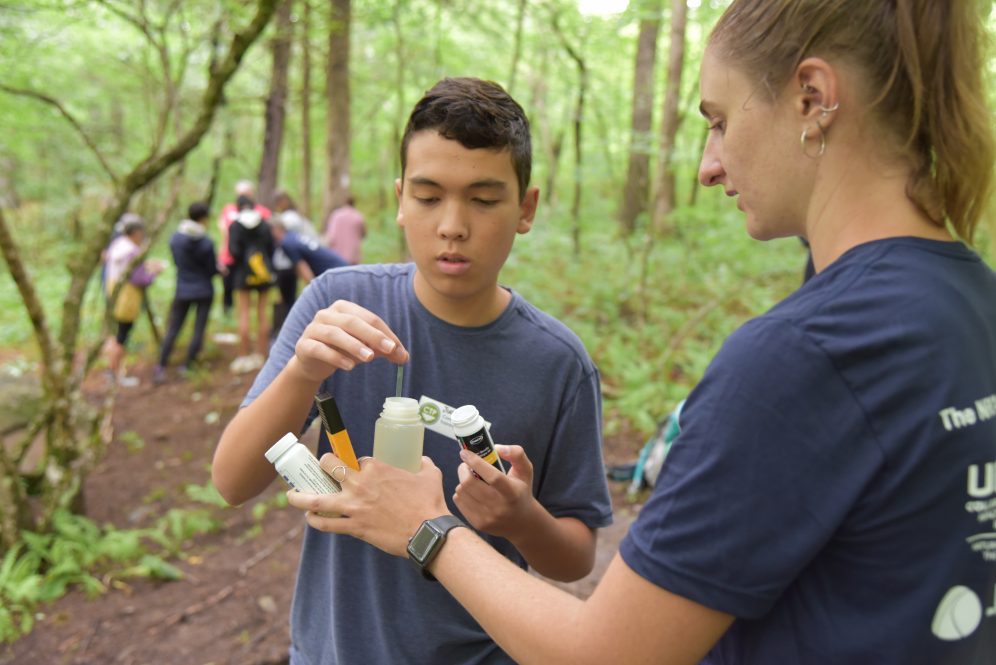You’re never too old to learn and you’re never too young to teach. This philosophy underscores a program that connects high school students and adult volunteers interested in conservation.
Laura Cisneros, assistant extension professor in the Department of Natural Resources and the Environment, recently published a paper in Frontiers in Education outlining the success of Conservation Training Partnerships, a community based environmental education and action program.
The program helps participants implement a variety of place-based environmental action (PBEA) projects that emphasize the importance of environmental action on an individual community level.
[Participants] can take skills and knowledge and apply it for real world action and see how project outcomes can benefit their community. — Laura Cisneros
“The rich environments that are in our backyards have value,” Cisneros says.
The program, the success of which Cisneros outlines in the paper, partnered community youth and adult conservationists. This program was funded by a grant from the National Science Foundation Advancing Informal STEM Learning Program.
UConn’s Natural Resources Conservation Academy had already been running a PBEA program for high school students in the state. Local conservationists involved with the program expressed an interest in receiving the same kind of training to the high school students.
“Local conservationists are often volunteers,” Cisneros says. “They have a wealth of knowledge of local conservation issues, but they often come in with no formal conservation training.”
Teen and adult participants are paired based on the location of their communities and their mutual interests.
“One of the really cool outcomes of these projects is building trust and relationships between community members across generations,” Cisneros says.
The workshop component of the program trains participants in skills like using mapping technology, data collection tools, and equipment to study wildlife, water quality, and more. Many of these tools are easily accessible through smartphones.
After learning and practicing these skills, participant pairs develop and implement their own PBEA project.
Projects in this program ran the gamut including an interactive trail map featuring pop-ups with information about ecologically important features; a sustainability fair highlighting community resources for composting, recycling, clean energy and more; and an urban tree reuse program that took diseases trees slated for removal and turned them into park benches.
This program was designed around four design principles, which Cisneros outlines in the publication.
The first principle is connecting the project to teen and adult interests. Participants are encouraged to draw on their past experiences and unique expertise to enrich their projects. This also helps participants strengthen their scientific identity and come to see themselves as someone capable of performing important scientific and conservation work.
The second principle is relating projects to real-world challenges and community need.
“It’s not just a hypothetical,” Cisneros says. “They see how they can take skills and knowledge and apply it for real world action and see how project outcomes can benefit their community.”
The third principle emphasizes the importance of connecting projects to disciplinary knowledge. This concept encourages collaboration beyond the program participants and enmeshes their projects in a broader scientific context.
“They’re not reinventing the wheel,” Cisneros says. “They’re using practices researchers and environmental professionals are using today.”
The fourth principle involves sharing these projects publicly. This helps participants and their projects reach the broader community they serve.
Cisneros would like to expand the program to include a focus on scientific communication. This next step will help ensure these community-facing programs are reaching people outside the program.
“How do we get these projects back to the community in an engaging way?” Cisneros says.
Cisneros says she would also like to see the program adopt more explicit anti-racist practices that emphasize the importance and value of different cultures and assets.
“There’s a concerted effort to incorporate more culturally relevant and justice-centered approaches within our programs,” Cisneros says.
So far, the program has supported a total of 221 teen and adult participants who completed 71 community conservation projects since 2017.
Follow UConn CAHNR on social media



